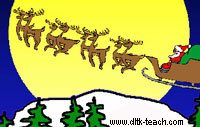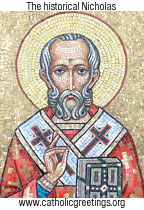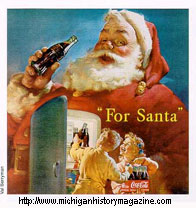Who
is Santa Claus (圣诞老人)
December 2007 Michael Krigline www.krigline.com
 Santa
Claus is not so much a person as he is an idea, but this idea started with
a real person many centuries ago. Around the world, “Santa” has many
names: Santa Claus, Sinter Claas, Saint Nicholas, St Nick, Kriss Kringle,
Father Christmas and many more. But the first "Santa" lived in the 4th
century; he was a Christian leader named Nicholas, living in what we
now call Turkey. After his wealthy parents died, he spent his life
secretly doing good things for others, especially children, the poor,
and sailors. He was later honored with the Christian title “Saint,”
and thus became St. Nicholas.
Santa
Claus is not so much a person as he is an idea, but this idea started with
a real person many centuries ago. Around the world, “Santa” has many
names: Santa Claus, Sinter Claas, Saint Nicholas, St Nick, Kriss Kringle,
Father Christmas and many more. But the first "Santa" lived in the 4th
century; he was a Christian leader named Nicholas, living in what we
now call Turkey. After his wealthy parents died, he spent his life
secretly doing good things for others, especially children, the poor,
and sailors. He was later honored with the Christian title “Saint,”
and thus became St. Nicholas.
Like many governments before and since,
the leaders of the Roman Empire considered Christianity to be a threat,
so St. Nicholas and other Christian leaders also spent many years in
jail because of their deeply-held faith.

One of the most famous stories of Nicholas’s generosity is about a poor
man who needed a dowry for each of his daughters. When it came time
for the oldest daughter to marry, Nicholas dropped gold coins down the
poor father’s chimney, and they landed in the daughter’s socks
(which were hanging by the fire to dry). Everyone thought it was a
miracle. Money also mysteriously appeared the night before the next
daughter was to marry. When it came time for his youngest daughter to
marry, the poor man stayed up all night and discovered that the gifts had
come from Nicholas.
By the time he died, Nicholas was so well known for secretly supplying
needs that people were giving him credit for every unexpected gift. Later,
his kindness was remembered with “the Feast of St. Nicholas” in early
December, which eventually moved to Christmas Eve.
As Christianity spread from culture to culture, the man’s name was
translated differently. In Holland it is “Sinter Claas,” which
became “Santa Claus” (or just “Santa” or “St. Nick”) in America.

In each country, the character is a bit different. In Holland he has a
tall red hat and uses a white horse; in the UK, "Father Christmas" is tall
and slender; in Russia, "Grandfather Frost" has a red suit and white
beard; in Germany, "Pelze Nicol" or "Kris Kringle" may wear fur or bells
and arrive by mule or horse; in Sweden, "Jultomten" is a short elf
(with a red tasseled cap and a long white beard) who rides a goat.
In other countries, children say gifts come from the "three wise men"
or some other character. Countries where the celebration of Christmas is
relatively new (such as China and Japan) have adopted the American Santa
Claus.
Who created America's version of Santa? In the 18th century, Major Henry
Livingston Jr. (1748-1828) wrote a poem giving a new magical dimension to
the character of St. Nicholas. Livingston invented a flying sleigh,
magic reindeer (and he gave them names!), and more. This poem was
originally called “Account of a Visit from St. Nicholas”; it was later
published citing Clement Clarke Moore as the author. Cartoonist Thomas
Nast drew pictures based on the description in this poem, and both the
pictures and the poem became very popular. Livingston's poem, Nast's
cartoons, and popular Coca-cola ads (created by Haddon Sundblom from 1931
to 1964) turned “St. Nicholas” into the “jolly fat man” Americans now
celebrate as “Santa Claus.”
Wherever he is
remembered, and no matter how you picture this jolly gift-giver, “Santa” (圣诞老人)
has come to symbolize generosity at Christmastime all over the world.
Vocabulary:
4th century: AD 300-399
chimney: a pipe or brick
tunnel through which smoke leaves a building (particularly over an open
fire or hearth)
dowry: a gift of money or
other possessions, given by a bride's parents to the new husband’s parents
elf: an imaginary and
magical "person," usually small with pointed ears
Holland: a European
country (officially called the Netherlands) known for its windmills;
people from here are called Dutch, and many Dutch people helped to settle
America (New York was originally named after a city in Holland: New
Amsterdam.)
jail: a place where
governments put people to either punish them or to keep their ideas from
influencing society
the poor: all poor people,
considered as a group
reindeer: a large, fast
animal with antlers (horns), that lives in extreme north, cold places
sailors: people who work
on ships (throughout history, this has been a difficult yet important job)
sleigh: a vehicle used in
the snow, pulled by one or more horses or other strong, fast animals
tasseled: decorated with a
small ball at the tip, often made of fur or white threads
a threat: something that
is regarded as a possible source of danger or instability
three wise men: part of
the Christmas story, which says that "wise men from the east" saw a new
star proclaiming that a king had been born in Israel; they followed the
star and found Jesus, and then gave him precious gifts (gold, incense) to
show their respect and worship.
Turkey: a country on the
Mediterranean sea, considered part of Asia and Europe. It was an important
part of the Roman Empire, then it was a main center for Christianity, and
later the center of the Islamic Ottoman Empire.
(For more information about Christmas, see these Christmas pages on our
website: the traditional Christmas story,
who is Santa (圣诞老人)?,
candy canes,
Christmas Perspectives (poem), and the pre-Christmas Advent season.
Also look for Christmas wallpaper
here. You'll also find movie study guides on this website for some
great holiday films: A
Snoopy/Charlie Brown Christmas, Last Holiday,
White Christmas, The
Grinch, Christmas Carol,
It's
a Wonderful Life)
Sources include:
Celebrate Christmas Around the World,
by Beth Dvergsten Stevens; Teacher Created Materials, Inc. 1994
http://www.christmas-day.org/real-saint-nicholas.html;
Society for the Confluence of Festivals in India (SCFI). (Visit the SCFI
website for free Christmas downloads, such as clip art and wallpaper:
http://www.christmas-day.org/christmas-clip-art.html)

This resource was created for our students under my
understanding of "fair use" for educational resources.
As far as I am concerned, people are allowed to
print/copy it for personal or classroom use.
(see Website Standards and Use Policy)
 Santa
Claus is not so much a person as he is an idea, but this idea started with
a real person many centuries ago. Around the world, “Santa” has many
names: Santa Claus, Sinter Claas, Saint Nicholas, St Nick, Kriss Kringle,
Father Christmas and many more. But the first "Santa" lived in the 4th
century; he was a Christian leader named Nicholas, living in what we
now call Turkey. After his wealthy parents died, he spent his life
secretly doing good things for others, especially children, the poor,
and sailors. He was later honored with the Christian title “Saint,”
and thus became St. Nicholas.
Santa
Claus is not so much a person as he is an idea, but this idea started with
a real person many centuries ago. Around the world, “Santa” has many
names: Santa Claus, Sinter Claas, Saint Nicholas, St Nick, Kriss Kringle,
Father Christmas and many more. But the first "Santa" lived in the 4th
century; he was a Christian leader named Nicholas, living in what we
now call Turkey. After his wealthy parents died, he spent his life
secretly doing good things for others, especially children, the poor,
and sailors. He was later honored with the Christian title “Saint,”
and thus became St. Nicholas.

